Are you tired of guessing how long to smoke ribs at 250°F? Trust me. I’ve been there. In a nutshell, smoking pork ribs at 250°F typically takes me around four to five hours on my pellet smoker. That’s for my pork spareribs. For my baby back ribs, I always plan to smoke them for less time because they cook faster than spare pork ribs.
The length of time to smoke ribs at 250°F depends on several factors. These include the thickness of the ribs, the cut of ribs (baby back, spare rib, short rib, etc.), how evenly your smoker burns, and your desired doneness level.
And while I’ll give you approximate cooking times, in bbq, we don’t cook to time. We cook to doneness. I’ll let you in on a handful of indicators that will let you know you’ve cooked your ribs to perfection.
So, are you ready to master the art of smoking ribs? Fire up your smoker and let’s get started.
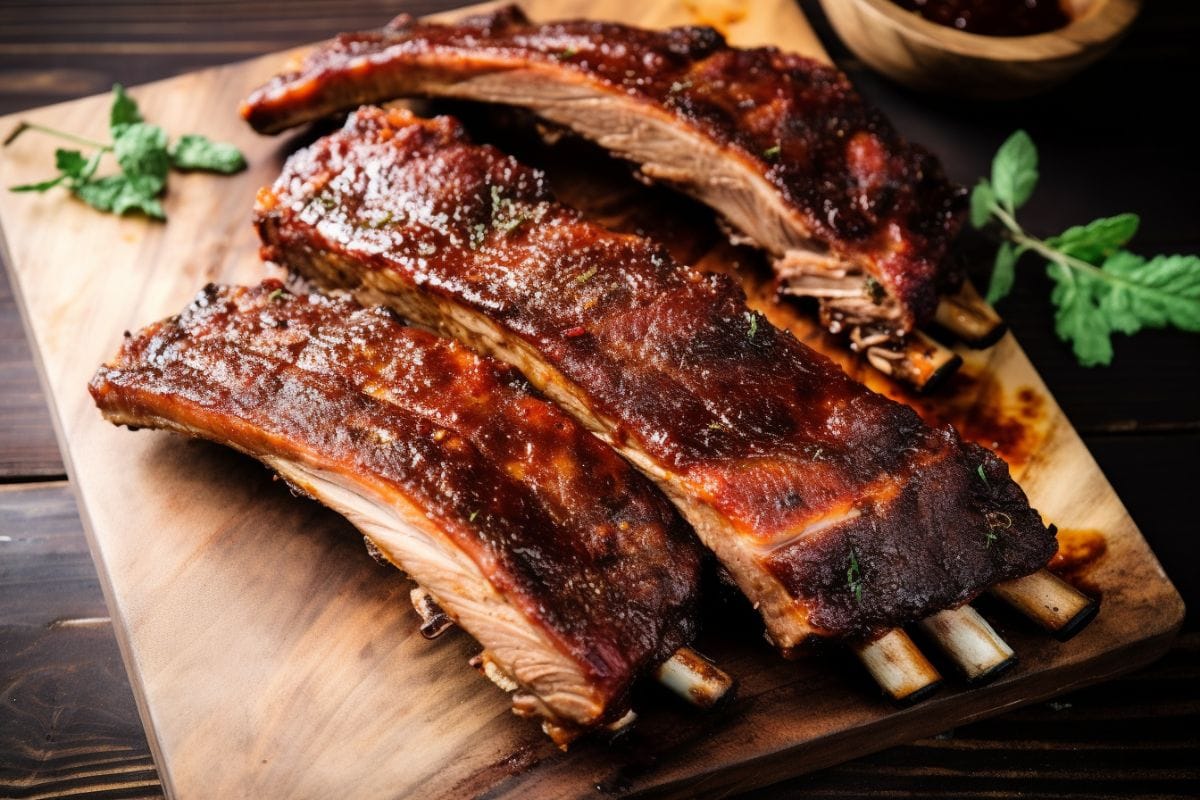
You’ll want to smoke ribs for about four to five hours. Again, how long to smoke ribs depends on the thickness of the ribs and the desired level of doneness. Some people prefer their smoked ribs to be fall-off-the-bone tender, while others like them to be a little chewy. Me? I like my ribs so tender that you could serve them at a nursing home, and residents could eat the ribs with their dentures.
In any case, it’s best to check them every hour or so to see how they’re coming along. If you’re saucing your ribs, be sure to baste them with your favorite BBQ sauce during the last 30 minutes of cooking to give them that extra kick of flavor.
Remember that it’s essential to use a meat thermometer. I always recommend instant-read thermometers like the ThermoPro TP03. This will help you monitor the internal temperature of the ribs so they don’t overcook or undercook.
The USDA recommends at least 145°F for safe consumption of pork. But when smoking ribs, we’ll cook them to around 200°F – well beyond the USDA’s safe cooking recommendations.
Ribs can be smoked at both 225°F and 250°F, and you’ll find pit masters who squabble over “the perfect cooking temperature.” In my experience, both cook temps will result in ribs that will leave your family and neighbors full-bellied and raving about your grill skills. The current general consensus among the bbq community is that 250° is the ideal cooking temp for ribs.
Still, both 225°F and 250°F are excellent temperatures to smoke ribs low and slow. However, the temperature you set should depend on your planned cooking time, the doneness level you want, and how thick your ribs are.
In any case, both cooking temperatures have their advantages.
Smoking ribs at 225°F brings about a longer cook time and allows the flavor of the smoke to permeate the meat more deeply, resulting in perfect ribs with a more intense smoky flavor.
This temperature is also great for the low and slow cooking process, which can help prevent the ribs from drying out.
On the other hand, smoking ribs at 250°F will have a shorter cook time.
Ultimately, the choice between 225°F or 250°F depends on your preference and the smoker you use. Some people prefer a longer cook time and the deeply smoky flavor achieved at 225°F, while others prefer a shorter cook time at 250°F.
Related Reading
Smoking ribs at around 250°F without foil will take about four to five hours, depending on the factors mentioned.
It’s important to note that smoking ribs without foil allow the smoke to penetrate the meat more deeply, resulting in a more intense smoky flavor.
However, it also increases the risk of the ribs drying out. So it’s crucial to monitor them throughout the cooking process and check their internal temperature regularly. I’ll also go over some of my favorite techniques for keeping your ribs super juicy and tender later in this article.
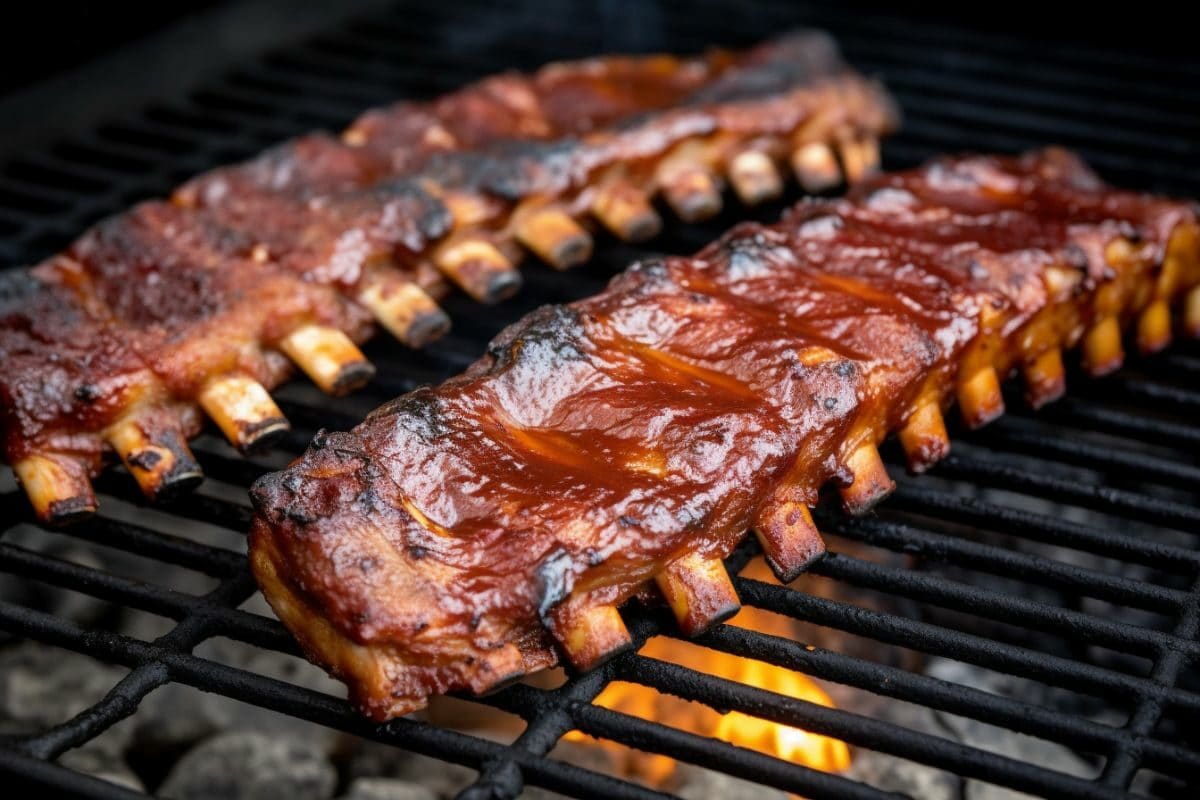
Yes, you can smoke ribs in 4 hours, but it depends on the cut of meat you select, the thickness of the ribs, and how tender you like your smoked ribs.
For example, some people prefer their smoked ribs to be fall-off-the-bone tender, while others like a little bit of chewiness.
When smoking ribs at 250°F for four hours, they won’t achieve fall-off-the-bone consistency. They’re going to have a little tug. It’s best to check them every hour or so with a thermometer to see how they’re coming along and ensure that they are cooked to your liking.
You can also wrap the ribs in foil after 2 hours to help them cook faster. Many pitmasters add butter to their foil for extra fatty goodness. Others add liquids, such as beer or apple cider, to their foil-wrapped ribs, which steams the ribs and makes them ultra-tender.
From beef to pork ribs, there are several types of ribs, and when each is cooked at 250°F, cooking times vary:
The most commonly smoked pork ribs are spare, St. Louis Style ribs, and baby back ribs.
Who can forget the epic Chili’s jingle? I want my baby back, baby back, baby back, baby back. Those commercials catapulted baby back ribs into the spotlight, and now, when most people think of ribs, they think of baby backs.
This rack of pork ribs is the most tender and leanest type of ribs. This is why I mentioned they cook faster. Baby back ribs are cut from the top of the pork loin and usually measure about 1 to 1.5 pounds per rack on the scale.
You can cook these pork ribs at 250°F for around four hours or until they reach an internal temperature of around 200°F, depending on your preferred doneness level. We’ll review some tricks to determine if your ribs are perfectly cooked later in this article.
These pork ribs are cut from the belly of the pig and are meatier, fattier, and bonier than baby back ribs. They usually weigh around two to three pounds per rack and have a thicker bone structure.
I like to cook my spare rib racks at 250°F for four to five hours.
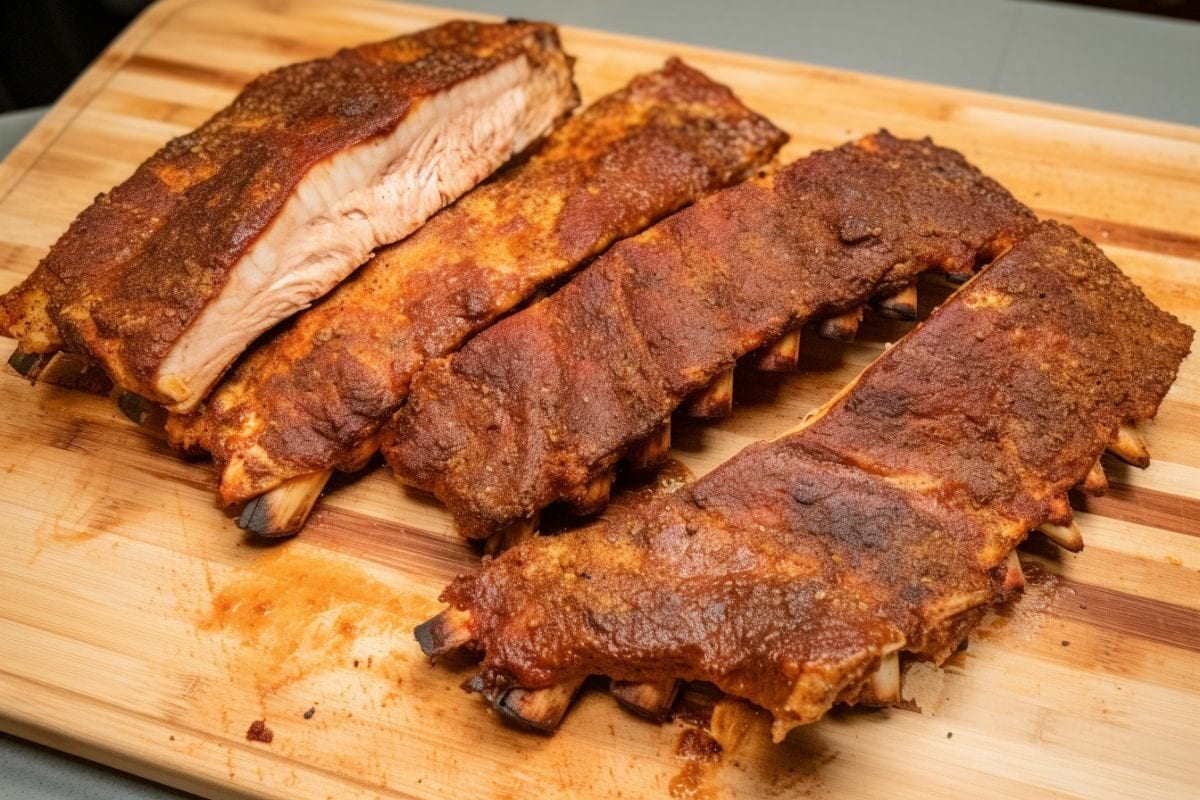
St. Louis-style ribs are spare rib racks that have been trimmed of the cartilage and brisket bone, giving them a more uniform shape.
Like the spare pork ribs, St. Louis-style ribs typically weigh around 2 to 3 pounds for each rack. You can also cook St. Louis-style ribs at 250°F for four to five hours.
There are several cuts of beef ribs, including short ribs, back ribs, plate ribs, and chuck ribs. Though pork ribs outsell their beef counterpart by a wide margin, sleep on beef at your own peril.
One of my prized recipes is for Argentinian short ribs with chimichurri sauce. I combine parsley, garlic, oregano, olive oil, and a few other ingredients to make a pungent, incredibly fresh, mouth-watering sauce. The smoked beef ribs are dipped in or plastered with the sauce, and they’re what barbecue is all about.
Short ribs are beef ribs cut from the cow’s brisket, chuck, or plate. They are meatier than pork ribs, and contain more fat, making them a rich and flavorful cut. They are usually cut into rectangular pieces and are often braised or slow-cooked.
Since beef ribs are larger than pork ribs, cooking them at around 250°F will take more time than pork ribs. You also need a low temperature to slowly break down the connective tissue and fat in the meat, making it tender and flavorful.
I recommended cooking beef short ribs for about five to six hours at 250°F.
Short ribs can be subcategorized as plate short ribs or chuck short ribs.
Plate ribs are cut from the front of the cow, near the belly. They are meaty, and packed with beefy flavor. They are typically cut into long, thin strips and are often used to make ground beef or short rib stew.
On the smoker at 250°F, beef plate ribs will need six to eight hours for a typical three-bone rack. It requires longer cooking time because it’s a big and beefy rib that’s taken from a tough part of the cow (close to the brisket region – some butchers call them “brisket on a stick”).
Also known as chuck short ribs, beef chuck ribs are a cut of beef that comes from the chuck primal, located in the cow’s shoulder area. They are a more budget-friendly beef cut compared to other ribs, such as back ribs or short ribs.
Beef chuck ribs are meatier and contain more fat than other ribs, making them a rich and flavorful cut. If you can find them at your butcher shop (not all butchers or grocery stores carry short ribs), pounce on them. You’ve found a divine piece of meat to bbq.
The cooking time for beef chuck ribs at 250°F will depend on a few factors, such as the size and thickness of the ribs. However, a general rule of thumb is to cook them for about five to six hours.
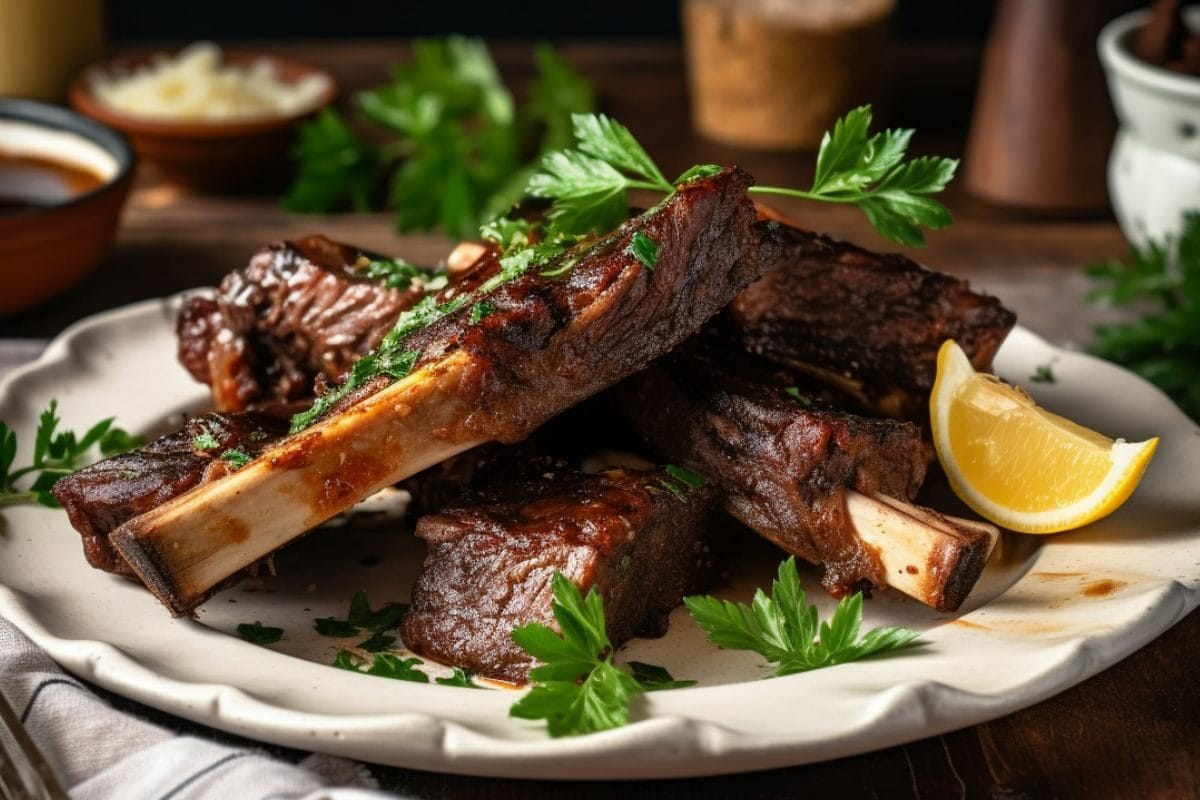
Back ribs, also known as rib roast or prime rib, are beef ribs taken from the upper ribcage of the cow. They are leaner and more tender than short ribs, so they’re ideal for direct grilling or roasting.
Beef back ribs are a massive, primal cut of cow that are great on the smoker. You’ll feel like Fred Flinstone biting into one of these monsters. I like to hit my back ribs with a Texas rub, then rub some freshly ground coffee beans onto the meat before smoking. Coffee and beef are a bold, natural pairing, and this Lonestar State Redeye special is stellar.
Cooking beef back ribs at 250°F will take about five hours, depending on the size of the ribs.
Here’s a general guide on how to smoke ribs on the smoker at 250°F:
Do you like your ribs fall-off-the-bone tender, or do you prefer them to have a little chew? In my experience, most people like their ribs to fall off the bone. If you’re smoking ribs for a competition, however, you’ll want to leave a little chew on them.
There are a handful of methods for testing the doneness of ribs. Using an instant-read digital thermometer is an excellent place to start. Finished ribs should read between 190°F and 205°F. Don’t cook your ribs past 210°F, as water will begin to evaporate from them at this temperature, and they’ll become dry and as tough as shoe leather.
Slide a toothpick or the probe of a thermometer into the meat of your ribs. There should be little to no resistance. For ultra-tender ribs, you’re going for a “hot knife through butter” sensation.
Grab the ribs in the center with tongs, and lift them off your cooker. The ribs should bend, and the meat will crack slightly.
When cooking pork ribs, the meat should contract from the bones by 1/4-1/2”. Beef ribs are larger, and the meat will contract more, around 1/2-1”. Give a rib bone a tug. If you want extremely tender ribs, the bone should wriggle out with no meat attached to it. For ribs with a little more bite, the bone will give some resistance when tugged on.
Here are a few additional tips to keep in mind when smoking ribs on a smoker:
When choosing ribs for the smoker, there are a few things to keep in mind.
First, consider the type of rib. There are various ribs from the pig and the steer. Choose one of the pork ribs if you want tender, meaty, fall-off-the-bone, and delicious smoked ribs with classic rib flavor.
On the other hand, beef ribs are great for serving a gathering as they’re bigger. I love beef ribs, which can be every bit as good as their bovine counterpart, and I grab them whenever my butcher is selling them.
Next, look for ribs with a good amount of marbling or small flecks of fat running through the meat. More fat means more flavor, and a well-marbled rack of ribs will yield morsels of meat that are rich and delicious.
The better quality of meat you purchase, the better the end results. Most BBQ restaurants serve USDA Prime grade or higher. Buy the choicest cut that fits within your budget.
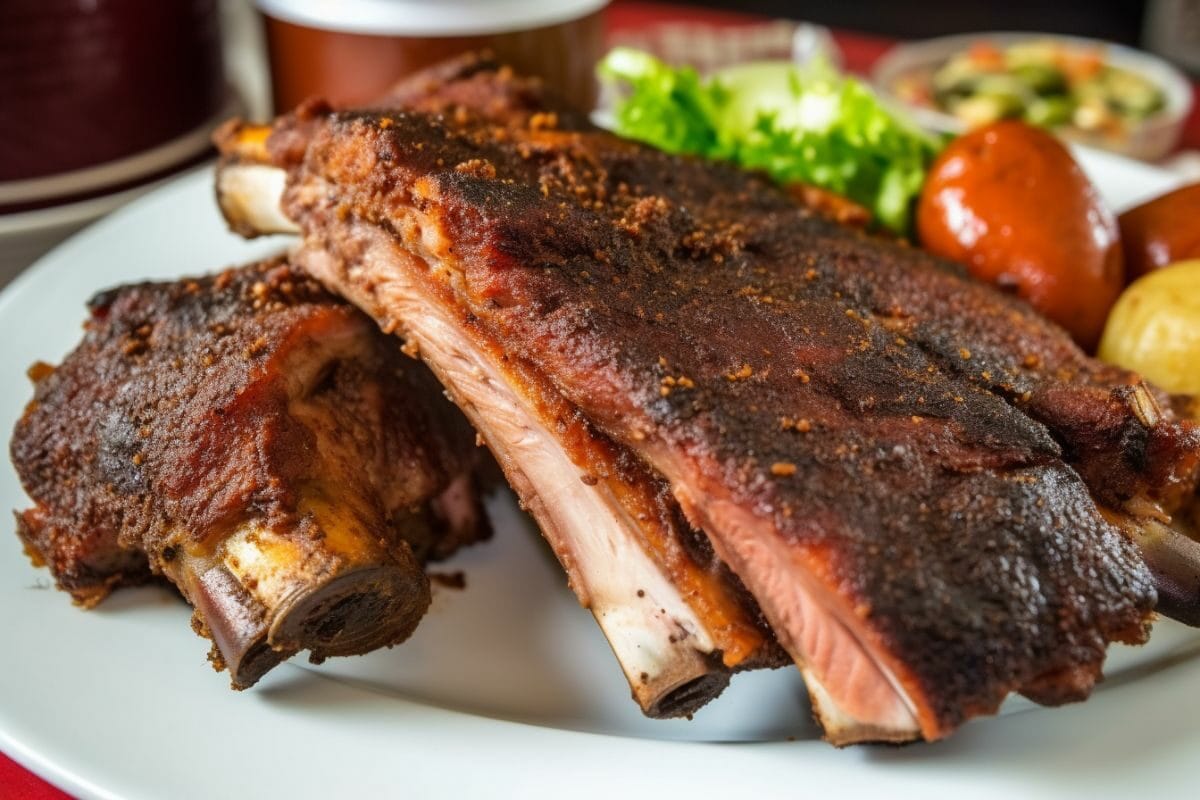
Inspect the meat for any discoloration or signs of spoilage. The meat should be a deep red color and should not have any slimy or discolored areas.
Finally, consider the size of the ribs. How many mouths are you feeding? Cook a half rack of pork ribs per person and 1-2 beef ribs per person.
Overall, I look for fresh ribs that are richly marbled and are the right type and size for my needs before purchasing.
When smoking ribs, the type of wood chips you use can greatly affect the flavor of the smoked ribs.
Here are some popular woods that are commonly used for smoking ribs:
Oak wood chips are versatile medium-intensity wood known to burn hot and long, making them great for smoking ribs low and slow. Oak imparts a rich, sweet smoky flavor that complements the taste of the meat without overpowering it. Oak and beef short ribs are a perfect pairing. Barbeque was invented in Texas, and in Texas, they smoke with oak. Try some on your ribs for true barbeque nirvana.
Pecan is a mild-flavored wood that burns hot and slow. It transfers a nutty, sweet flavor to meat and tastes great with pork.
Apple wood chips are mildly flavored wood that burns slow and hot. It imparts a delicate, fruity flavor to the ribs. Apple and pork are a natural classic pairing.
Cherry wood is a mild-flavored wood that burns hot and slow. It lends a sweet, fruity flavor to beef, pork, or any food you smoke.
Maple wood is a mild-flavored wood that burns hot and slow. It transmits a subtle sweetness and smokiness to the smoked ribs, complementing the beef and pork.
Tips: It’s worth mentioning that you may also mix different woods to create your unique flavor. Experiment! Find the combination you like the most.
You can try a few different techniques to ensure your smoked ribs are moist.
One option is to wrap the ribs in foil with a small amount of liquid (such as apple juice or beer). Wrapped ribs trap moisture during smoking.
Another option is to baste the ribs with a mop sauce or liquid throughout the cooking process. This will also help to add more flavor to the ribs. Applying a mop sauce will help to prevent the meat from drying out.
You can also add a water pan to your smoker to add humidity and keep the ribs from drying out.
You can use a meat injector with marinade before smoking ribs to infuse the meat with flavor and liquid. Experiment with different ingredients to find what works best for you. Melted butter, apple cider, and seasonings are popular injector ingredients.
The “3-2-1” method involves smoking ribs for three hours without foil, then wrapping them in foil and cooking for an additional two hours, and finally unwrapping them and cooking for an additional hour.
Related Reading
You can also try using a “spritz” to moisten the ribs. A spritz is a spray bottle filled with a liquid such as apple juice or water, which you mist onto the ribs every 30 minutes or so during the smoking process.
For incredibly moist ribs, let the ribs rest for a few minutes before slicing or serving them. This allows the juices to redistribute and keeps the meat moist.
If you’re smoking ribs with a dry rub, add a little oil to the dry rub and apply it to the meat. Oil is a fat, and will help to keep the meat moist.
Overall, smoking ribs is part science and part art. It may take some experimentation to find the best methods for keeping the ribs moist on your specific smoker. You can also combine these methods for better results.
If you don’t have foil, you can try a few different techniques to keep your ribs moist during smoking:
You can smoke ribs at a higher temperature, such as 300°F to 325°F. However, the ribs will cook faster, and you risk drying out the meat.
Smoking ribs at a lower temperature of 225°F to 250°F is recommended for the best results.
When smoking ribs, the best way to know when they are done is by checking with a meat thermometer. The internal temperature of the ribs should read between 190°F to 205°F. You can also check for doneness by gently twisting the bone. The ribs are done if the meat is tender and the bone pulls away cleanly.
Another way to figure out if your ribs are perfectly cooked is by inserting a probe or toothpick into them. There should be minimal to no resistance if you want your ribs to be incredibly tender.
Apply BBQ sauce approximately 30 minutes before the ribs have finished cooking. Adding the sauce too early can cause it to burn and make the ribs taste acrid. I also recommend brushing the barbecue sauce on with a basting brush. This will allow you to control the amount of sauce you add.
Smoke your ribs for four to five hours at 250°F to achieve tender and flavorful ribs. The cooking time will vary depending on the type, size, thickness, and desired doneness level of your ribs.
When smoking ribs, a low and slow temperature of around 250°F is recommended for the best results. Remember to let the smoked ribs rest for a few minutes before slicing or serving them. This will allow the juices to redistribute and keeps the smoked ribs moist. Happy smoking!